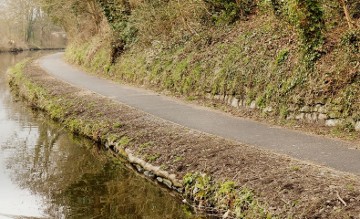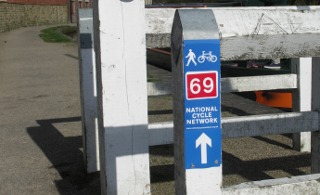The change in towpaths
On foot, we were frequently pushing our way through the undergrowth. (Some places where the grass cutters are parsimonious with their efforts are still like that!) Given the other maintenance priorities, I doubt whether to day's towpaths would be very different if it were just a matter of maintaining the facility for the use of boaters. After all, most of the time between locks they are on the boat not the towpath!
 Easily walkable
Easily walkable
As I understand it, little of the improvement—and today most towpaths are easily walkable and accessed by bicycle—has been funded from the budgets for canal maintenance. Instead, it has been the result of the involvement of local authorities who, in more enlightened times, saw the towpaths as excellent opportunities for developing new leisure facilities for their rate (council tax) payers.
We should be grateful that a very quiet aspect of canal restoration has been undertaken without being a burden to boaters directly. Of course, as is often the case when third parties make contributions to maintenance costs, it comes at a price: we, the boaters, have to share the towpath with non-boaters. In some ways this has brought additional intangible benefits in that many more people now have a stake in keeping the canals in good order and share in putting pressure on public bodies to keep them so.
 Sharing agreement
Sharing agreement
That said, there may well be a case for reviewing that 'sharing agreement' and to establish a better understanding of the needs of each other. Most of us, I am sure, would welcome it if this could be achieved without recourse to 'rules' which, so often, rebound with unintended consequences. Certainly some sort of understood speed limit might help but, especially in urban areas where towpaths have become significant routes to and from work, too much limitation might well undermine the case for putting council tax money into towpath maintenance. (What speed to do some joggers reach?)
Perhaps also anglers need to adopt good codes of practice not only with regard to boating use (such as knowing to keep away from locks, especially not fishing from lock landings) but also making sure that they do not present unsafe hazards to cyclists and walkers.
Towpaths are a precious resource and we had best learn to live together otherwise we might find ourselves back in the state that they were in in the 1960's.
